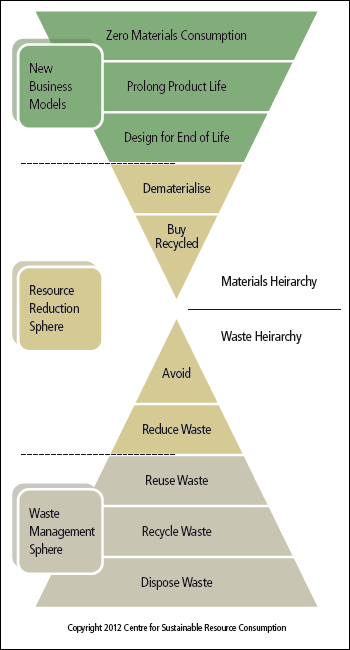Suppose you have made the commitment to make dramatic changes reducing use of resources. Now what do I do personally? What should a company do?
Experience with lean operations is good training for the next transition. Our friends in Australia, Ian Young and Anthony Peyton, developed the hourglass figure to help coach companies through this change process. They start by learning to see beyond waste as defined by lean; that waste is anything the customer would not pay for.

Young and Peyton often call this Beyond Waste Insight, presuming that a company has already made progress on lean as usually defined. Go into operations and look for materials waste using environmental glasses. Most of their conversion efforts so far have been in manufacturing companies.
Plug the air leaks and water leaks. Eliminate cardboard and other one-time use expendibles, or at least recycle them. Recycle your own scrap whenever possible. Start revising operations to eliminate all waste, including excess trim or cutting scrap. That’s waste too.
The first stretch objective is often zero-to-landill. Many American plants are also on this road to zero, but all the little changes take time. One company, Davey Water Products, cut the pounds sent to landfill by 85% in nine months, good progress. In time they will squeeze it to zero.
Regard landfill disposal as a last resort. Best: improve processes to eliminate the need for disposing of anything.
While working on operations improvements, which Young and Peyton call the waste hierarchy, start mapping what can be done in the upper half of the hourglass, which they call the materials hierarchy. What substitutions can be made in designs to either use less material or to use recycled material? Most companies make headway on this at the rate that they work through product design cycles. Of course, nobody can do everything at once. Beyond Waste Insight is a learning process.
Heavier lifting and the trickier changes are in the upper part of Young and Peyton’s materials hierarchy. How can we reduce the materials and energy used by products during their lifetime? At the end of a product’s life, how can we avoid disposing of it?
From a technical view, one has to get deep into life cycle analysis as a guide to rethinking the operations of customers as well as suppliers. However, real imagination and full system thinking is required to devise how to improve outcomes for your customers while using much less to do it. In most cases you will overhaul business models, regarding your company as a creator of better quality outcomes (a service business) rather than as a seller of quality stuff. Changing an established business model is never anything to take lightly. The effort will require education of customers in better ways to achieve quality results unless they are already on the same level of thinking.
Constantly emphasizing quality over quantity is a major change in business assumptions and philosophy. This is hard to visualize from the perspective we have now. However, an example of a manufacturer doing it is PortionPac Chemical in Chicago. Their story was in a previous update.
